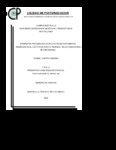| dc.description.abstract | El objetivo del presente trabajo fue evaluar la influencia de diferentes frecuencias de aplicación de nutrimentos minerales a través del fertirriego, sobre el crecimiento, desarrollo, rendimiento, calidad de fruto y contenido nutrimental en hoja y peciolo de papaya (Carica papaya L.) ‘Maradol’. Se utilizó un diseño experimental en bloques al azar con cinco tratamientos (3, 6, 12 y 24 días, como frecuencias de aplicación de la solución universal “Steiner” al 50%, en fertirriego, y aplicación de fertilizante granulado al suelo como testigo 150 150 150 kg ha-1 de N, P2O5 y K2O) y ocho repeticiones por tratamiento. Se evaluaron las variables altura de planta, numero acumulado de hojas, diámetro de tallo, altura del primer fruto, rendimiento, sólidos solubles totales, firmeza del fruto, pérdida de peso del fruto y contenido nutrimental en hoja y peciolo. En la etapa de plena floración no existieron diferencias estadísticas significativas (p 0.05), para las variables número de hojas y diámetro de tallo. Sin embargo, para la variable altura de planta, si hubo diferencias estadísticas significativas (p 0.05), siendo el mejor tratamiento aquel que recibió fertirriego cada 24 y 3 días, respectivamente. En la etapa de mayor amarre de frutos si se presentaron diferencias estadísticas significativas (p 0.05) para las variables diámetro de tallo y altura de planta, siendo los mejores tratamientos comparados con el testigo, aquellos que se les aplicó fertilizante a través del sistema de riego. Para las variables de firmeza y pérdida de peso del fruto no se presentaron diferencias estadísticas significativas (p 0.05); no obstante, para la variable de sólidos solubles totales si se reportaron diferencias estadísticas significativas (p 0.05) entre tratamientos, siendo el mejor tratamiento el que recibió fertilización granulada al suelo. En las etapas de mayor amarre, crecimiento y cosecha de los primeros frutos si hubo diferencias estadísticas significativas (p≤0.05) en la concentración de nutrimentos en peciolo y lamina de la hoja; registrándose una mayor concentración de N en el tratamiento que se le aplicó el fertirriego con mayor frecuencia. Asimismo, la concentración de P, K, Mg y micronutrimentos disminuyeron por efecto de dilución.______The objective of this research was to evaluate the influence of different frequencies of application of mineral nutrients through ferti-irrigation on the growth, development, yield, fruit quality, nutritional content of leaves and petioles of the Maradol papaya (Carica papaya L.). The experimental design was randomized block with five treatments: Treatment 1, the control, consisted of the application of granulate fertilizer (150 kg ha-1 of N, P2O5 y K2O), and treatments 2 through 5 consisted of the application of the universal nutrient solution “Steiner” (50% diluted). The nutrient solution Steiner was added through ferti-irrigation system. The frequency of application of the different treatments was 1, 3, 6, 12 and 24 days; treatment 1 was added at day 1, treatment 2 at day 3, and so on. Each experimental block was repeated 8 times. We evaluated the following variables: plant height, accumulated number of leaves, diameter of the stalk, the height at first fruit, fruit yield, total soluble solids, fruit firmness, fruit weight loss, and nutrient content in leaves and petioles. As experimental results, we found that during the flowering stage there were no statistical significative differences (p 0.05) in the number of leaves and diameter of the stalk; however, in plant height, we found statistical significance among treatments (p 0.05); the best treatments in plant height were ferti-irrigation added during day 3 and 24, respectively. In the fruit development stage, we found that there were statistical significance (p 0.05) in diameter of the stalk and plant height; in these two variables, the best treatments, compared with the control, were the ferti-irrigation treatments: 3, 6, 12 and 24, respectively. We did not found statistical significance in fruit firmness and fruit weight loss (p 0.05). Likewise, we did not found statistical significance (p 0.05) in total soluble solids; here, the best treatment was the application of granulate fertilizer. Finally, in the fruit development stage, growth and harvesting of the first fruits, we found statistical significative differences (p≤0.05) in the concentration of nutrients in stalks and petioles of the leaves; the N nutrient content was higher in the higher frequency ferti-irrigation treatments. In the same way, the nutrient concentration of P, K, Mg was reduced because of the dilution effect. | es |

